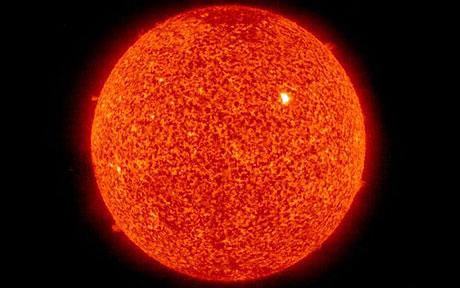The protective bubble around the sun that helps to shield the Earth from harmful interstellar radiation is shrinking and getting weaker, Nasa scientists have warned.

© APData has shown that the sun's heliosphere is shrinking
New data has revealed that the heliosphere, the protective shield of energy that surrounds our solar system, has weakened by 25 per cent over the past decade and is now at it lowest level since the space race began 50 years ago.
Scientists are baffled at what could be causing the barrier to shrink in this way and are to launch mission to study the heliosphere.
The Interstellar Boundary Explorer, or IBEX, will be launched from an aircraft on Sunday on a Pegasus rocket into an orbit 150,000 miles above the Earth where it will "listen" for the shock wave that forms as our solar system meets the interstellar radiation.
Dr Nathan Schwadron, co-investigator on the IBEX mission at Boston University, said: "The interstellar medium, which is part of the galaxy as a whole, is actually quite a harsh environment. There is a very high energy galactic radiation that is dangerous to living things.
"Around 90 per cent of the galactic cosmic radiation is deflected by our heliosphere, so the boundary protects us from this harsh galactic environment."
The heliosphere is created by the solar wind, a combination of electrically charged particles and magnetic fields that emanate a more than a million miles an hour from the sun, meet the intergalactic gas that fills the gaps in space between solar systems.
At the boundary where they meet a shock wave is formed that deflects interstellar radiation around the solar system as it travels through the galaxy.
The scientists hope the IBEX mission will allow them to gain a better understanding of what happens at this boundary and help them predict what protection it will offer in the future.
Without the heliosphere the harmful intergalactic cosmic radiation would make life on Earth almost impossible by destroying DNA and making the climate uninhabitable.
Measurements made by the Ulysses deep space probe, which was launched in 1990 to orbit the sun, have shown that the pressure created inside the heliosphere by the solar wind has been decreasing.
Dr David McComas, principal investigator on the IBEX mission, said: "It is a fascinating interaction that our sun has with the galaxy surrounding us. This million mile an hour wind inflates this protective bubble that keeps us safe from intergalactic cosmic rays.
"With less pressure on the inside, the interaction at the boundaries becomes weaker and the heliosphere as a whole gets smaller."
If the heliosphere continues to weaken, scientists fear that the amount of cosmic radiation reaching the inner parts of our solar system, including Earth, will increase.
This could result in growing levels of disruption to electrical equipment, damage satellites and potentially even harm life on Earth.
But Dr McComas added that it was still unclear exactly what would happen if the heliosphere continued to weaken or what even what the timescale for changes in the heliosphere are.
He said: "There is no imminent danger, but it is hard to know what the future holds. Certainly if the solar wind pressure was to continue to go down and the heliosphere were to almost evaporate then we would be in this sea of galactic cosmic rays. That could have some large effects.
"It is likely that there are natural variations in solar wind pressure and over time it will either stabilise or start going back up."
Reader Comments
to our Newsletter